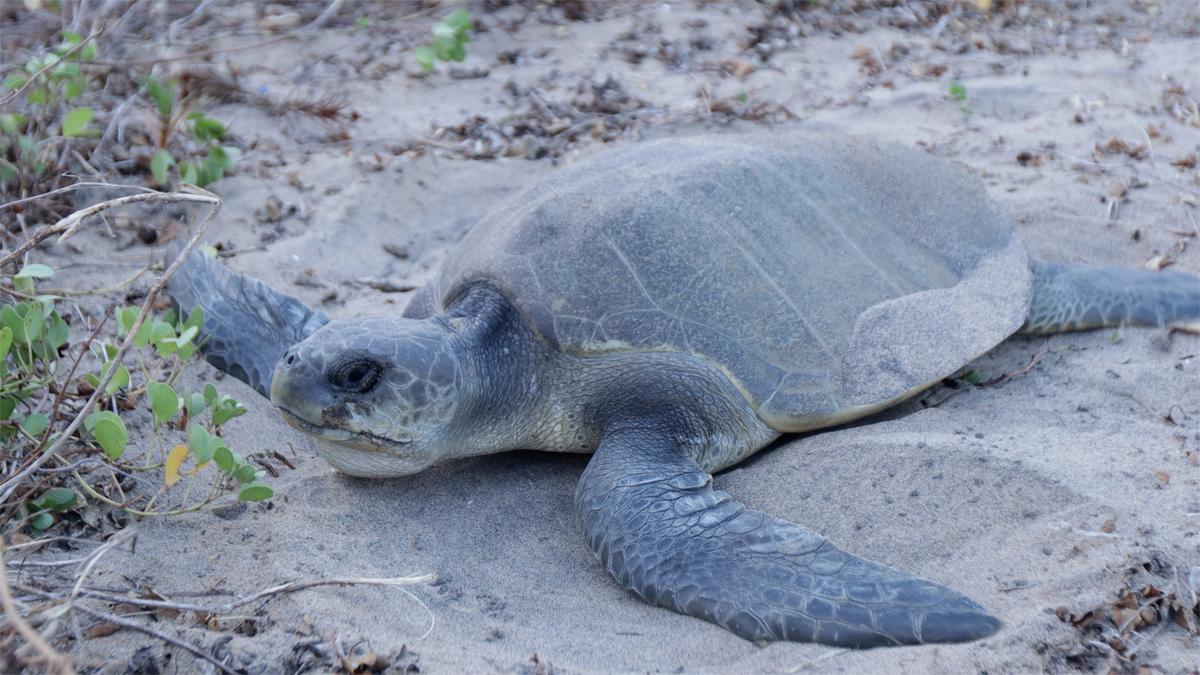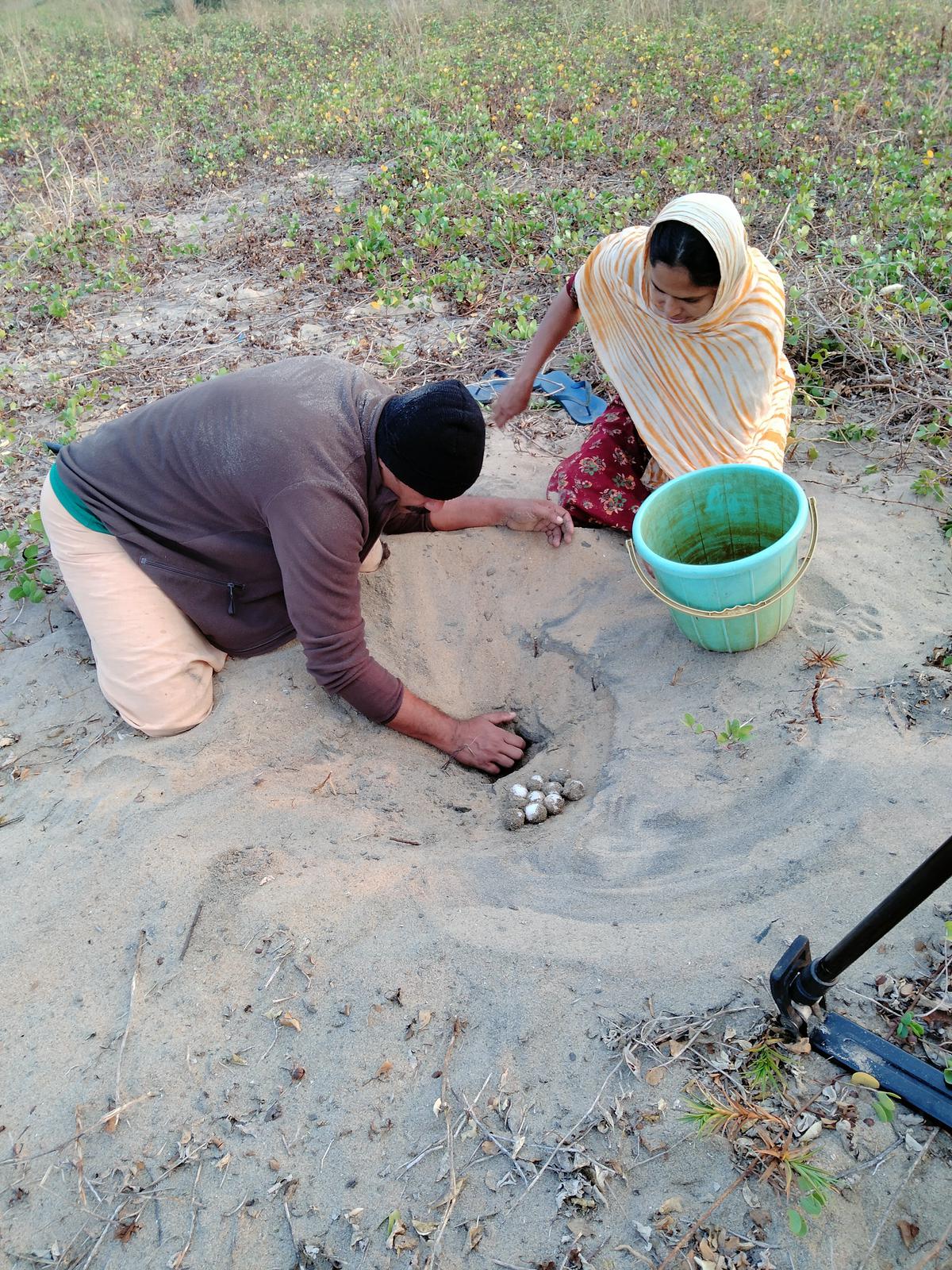On a moonlit night, on a beach at Chavakkad in Thrissur, Kerala, an Olive Ridley turtle swims in and makes its way clumsily to the empty beach, way beyond the shoreline. After cautiously surveying her surroundings, she uses her flippers to dig a hole in the sand. Once she is satisfied with the nest, she lays 132 eggs before noisily covering it with sand, making a slapping noise with her flippers. Then she goes down to the sea and is swept into the waters as the waves crash on the sandy shore.
Capturing the entire process on camera was Thiruvananthapuram-based documentary filmmaker Sasikumar Ambalathara.
It was the end of a long wait for Sasikumar who had been filming the endangered turtles’ nesting ground in Kerala. Although he had got footage of turtles laying eggs in the Gagirmata region on the Orissa coast, he was keen on shooting a turtle laying eggs on one of the beaches in Kerala.

A still from Sasikumar Ambalathara’s documentary Give Me A Little Land – A Loving Shore for The Sea Turtle. An Olive Ridley Turtle covers the pit it had made for laying its eggs on Chavakkad beach, near Thrissur
| Photo Credit:
SPECIAL ARRANGEMENT
“We had been waiting for days. My contacts at Chavakkad and Malappuram told me that turtles usually come ashore to lay their eggs close to full-moon or new-moon nights. On that particular night, I was waiting in my car. I had been warned by turtle watchers not to be too optimistic. So, it was a memorable moment when I was told that a turtle had been spotted on the beach,” says Sasikumar.

The poster of Sasikumar Ambalathara’s documentary Give Me A Little Land – A Loving Shore for The Sea Turtle
| Photo Credit:
SPECIAL ARRANGEMENT
His documentary Give Me A Little Land – A Loving Shore for The Sea Turtle, produced by the Kerala State Biodiversity Board, was initially made in Malayalam in 2022. It was dubbed into English in 2023 with a narration by Shobha Tharoor Srinivasan.
As the world observed International Day for Biological Diversity 2023 on May 22 with the theme to build back biodiversity, the 30-minute minute documentary underlines the importance of preserving the biodiversity of our eco-system. In the documentary, Dr A Biju Kumar, Head of the Department of Aquatic Biology Kerala University, explains that the turtles control population of jelly fish and seaweed by feeding on them.
Like most marine turtles, the Olive Ridley turtles are endangered because of marine pollution and destruction of their habitats.

Documentary filmmaker Sasikumar Ambalathara
| Photo Credit:
SPECIAL ARRANGEMENT
“Seawalls prevent the turtles from reaching the beach and coastal lights confuse them as they depend on moonlight to navigate the seas. Poaching is another danger,” adds Sasikumar.
Climate change threatens these turtles because the gender of a turtle depends on atmospheric temperature. Warmer temperatures result in females and cooler temperatures produce males.
What is unique about these turtles is that every year, pregnant females cover thousands of kilometres to nest in the shores where they were born. Once, the turtle used to nest all across the Malabar coast and even on certain beaches in Alappuzha.
Poachers turn protectors
“Poaching used to be rampant on the beaches in Kerala because there was a belief that turtle meat and eggs had curative properties for many illnesses. In several beach-side village, residents used to dig up the eggs and kill the turtles during the nesting season from November to February-end. The eggs used to cost around ₹200 some 20 years ago and there were many takers for it. What is heartening is that the same villagers are now the people protecting the turtles,” says Sasikumar.
The Forest Department, naturalists and greens joined hands to create awareness among the residents on why it is important to protect the turtles. The Olive Ridley turtles are protected under Schedule I of the Wildlife Protection Act of 1972.

Latheef Latheef and Khadeeja Latheef, turtle watchers on Chavakkad beach, near Thrissur, dig up the eggs of an Olive Ridley Turtle to transfer them to a hatchery to protect them.
| Photo Credit:
SPECIAL ARRANGEMENT
Now, the residents wait at night for the turtles to arrive to ensure that they are safe. Khadeeja Latheef and her husband Latheef Latheef are turtle watchers at Chavakkad. As soon as the turtle returns to sea after laying the eggs, the couple carefully dig up the eggs with the surrounding sand that has a protective liquid ejected by the turtle, and transfer them to a hatchery.
Till the end of the nesting season, villagers keep a close watch on their beaches all along the coastline in Kasaragod, Malappuram, Kozhikode, Thrissur and Alappuzha districts.
Veliyamkot, near Tenamuri beach in Malappuram, is a good example of how an entire village has come together to protect the turtles on account of the awareness programmes launched by the Forest Department and wildlife enthusiasts.

Veliyamkot, near Tenamuri beach in Malappuram have come together to protect the Olive Ridley turtles and their nesting areas.
| Photo Credit:
SPECIAL ARRANGEMENT
In 1998, the Government of India created the National Sea Turtle conservation Board project and the nesting sites of the turtles are protected areas.

A still from Sasikumar Ambalathara’s documentary Give Me A Little Land – A Loving Shore for The Sea Turtle, which shows the villagers carrying the hatchlings to release them into the sea.
| Photo Credit:
SPECIAL ARRANGEMENT
“Conservators look out for the marks made by the turtles to find the eggs. They collect the eggs and take them to the hatcheries. It takes about 45 to 50 days for the eggs to hatch. The turtles usually hatch at night and the villagers take care to release the hatchlings after sunset. Even then they have to protect them from dogs and foxes,” says Sasikumar.
He says that the entire process of filming the turtles has been an unforgettable experience for him. “Above all that, if it can help in someway to highlight the importance of working towards a sustainable future that nurtures the environment, that would be my biggest reward,” says Sasikumar.
For all the latest Entertainment News Click Here
For the latest news and updates, follow us on Google News.
